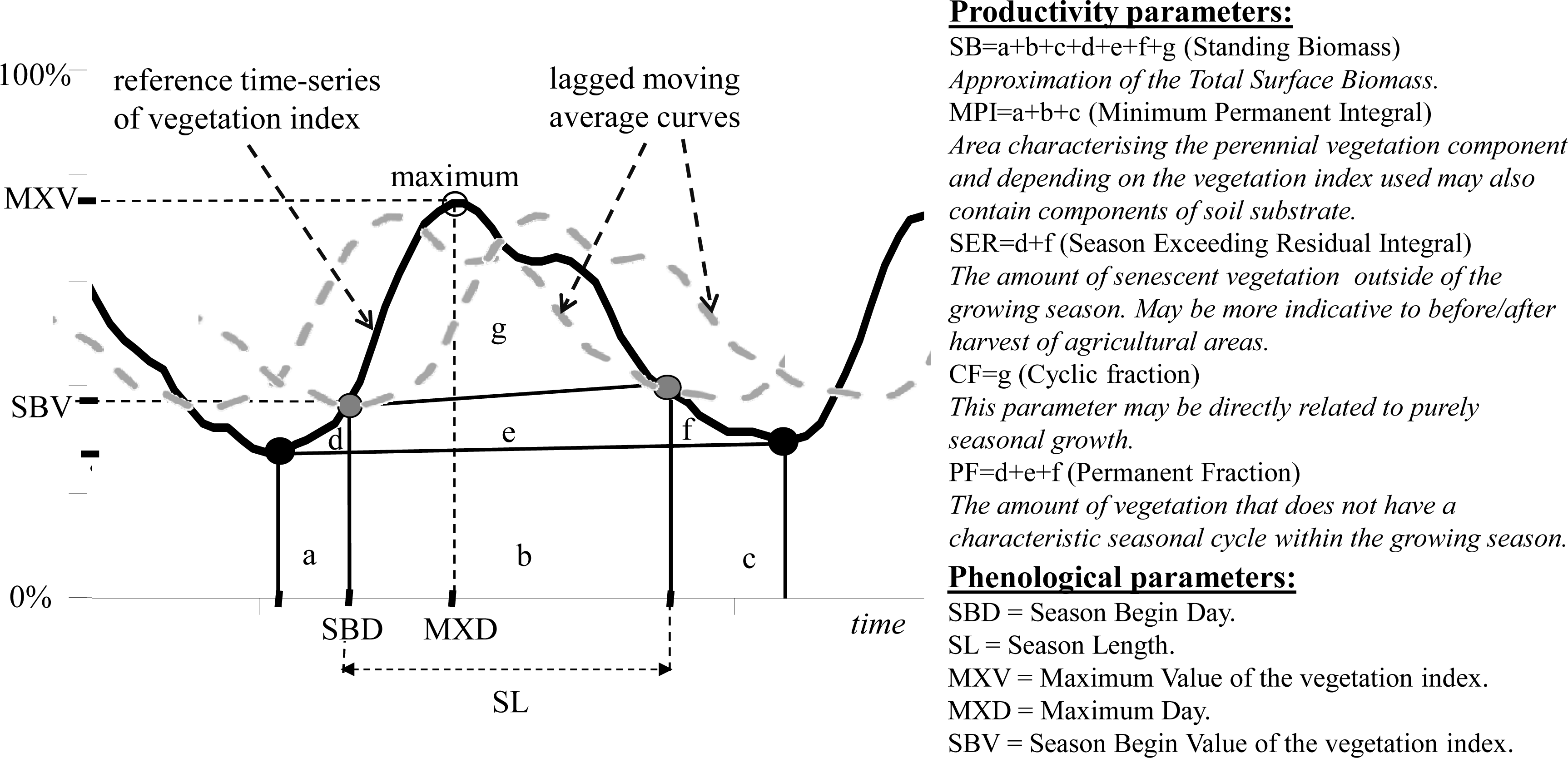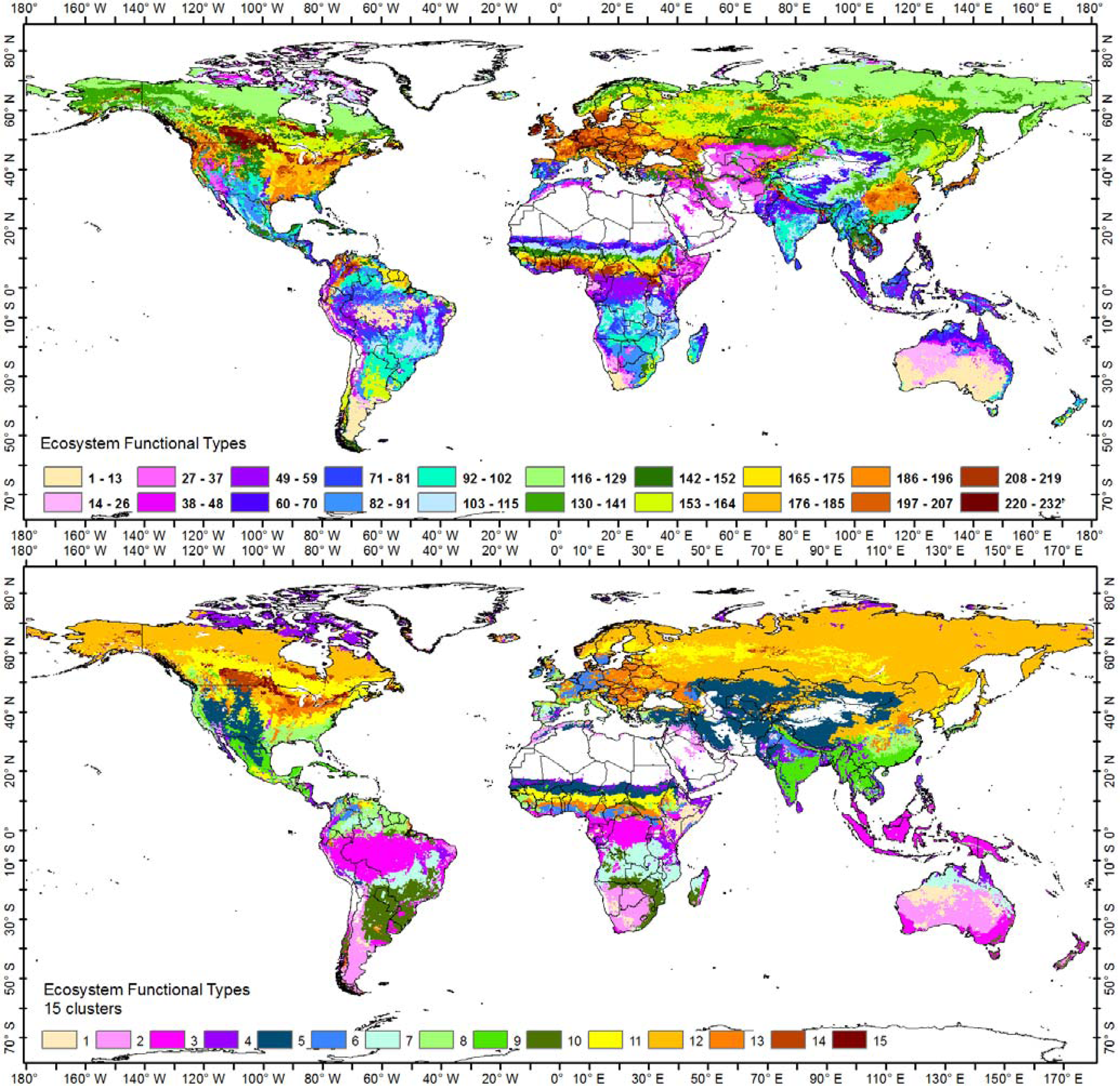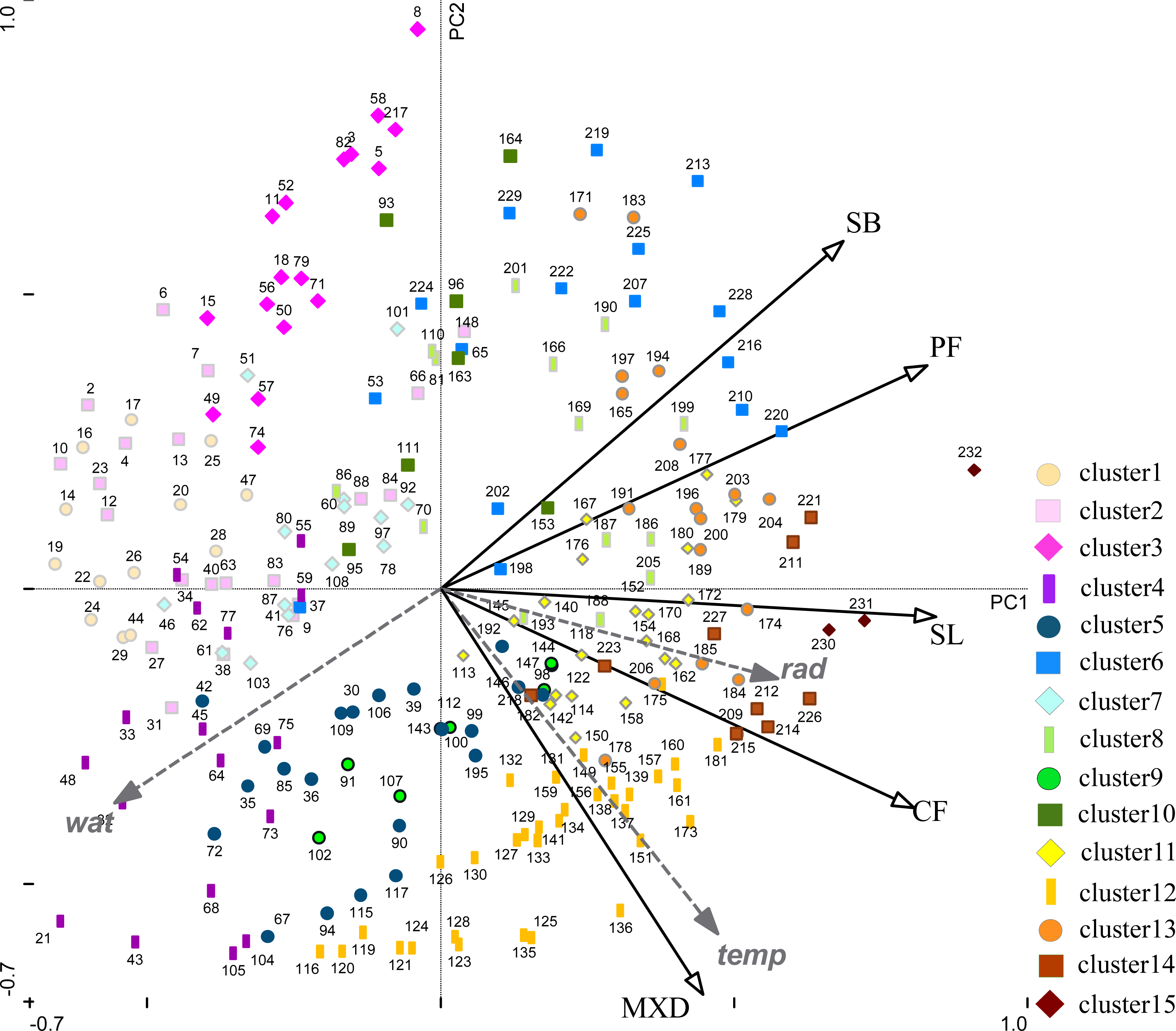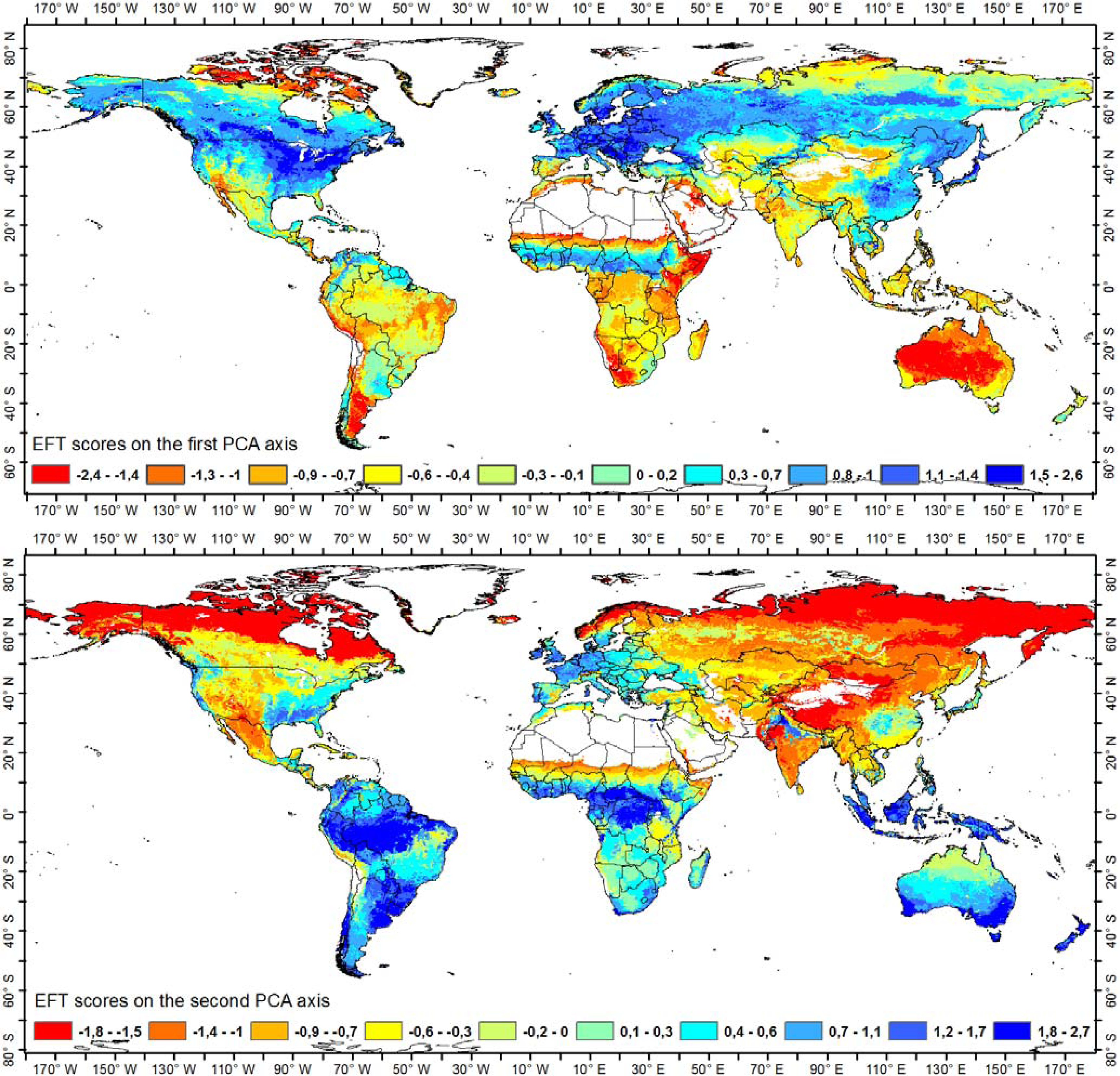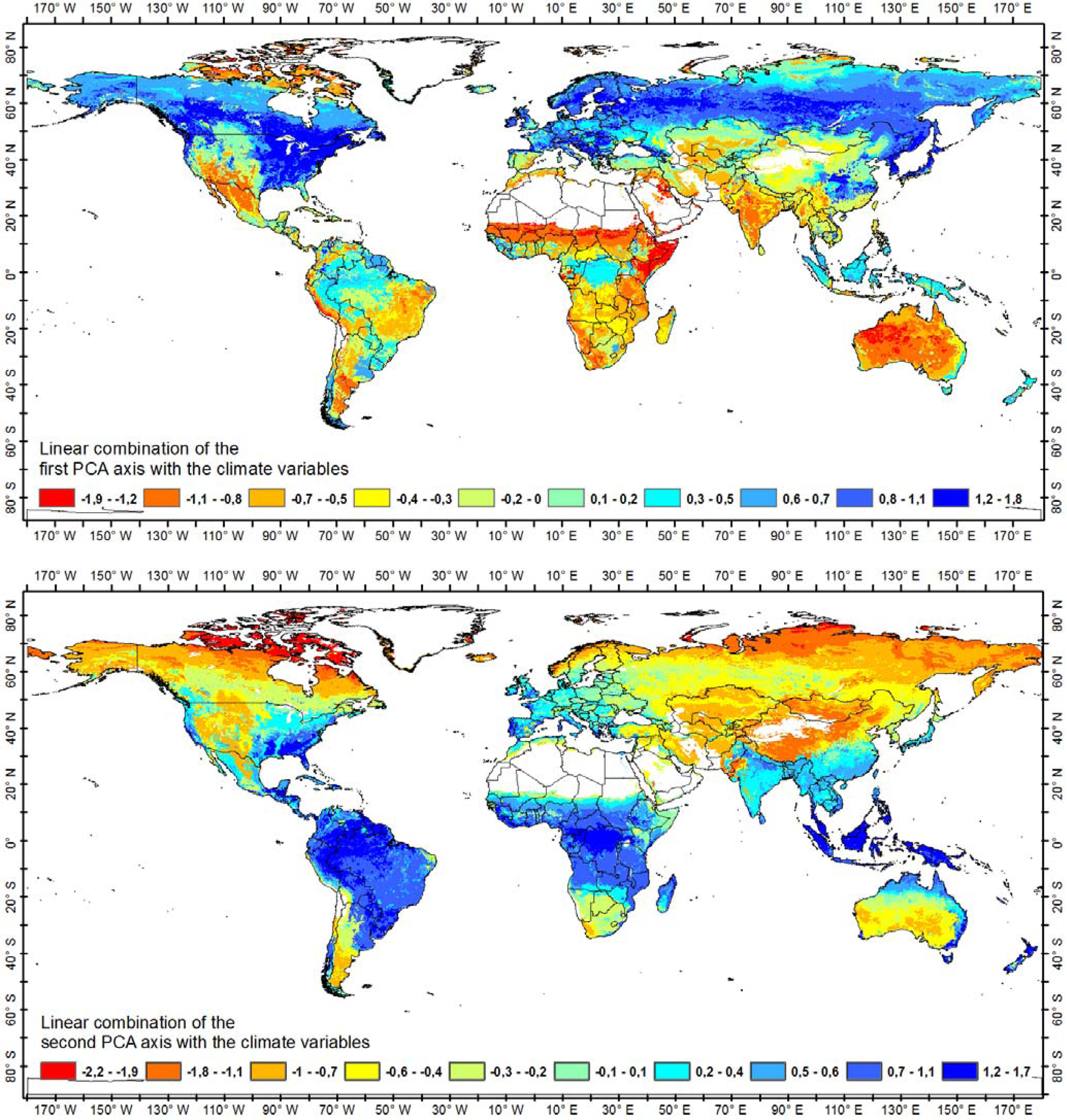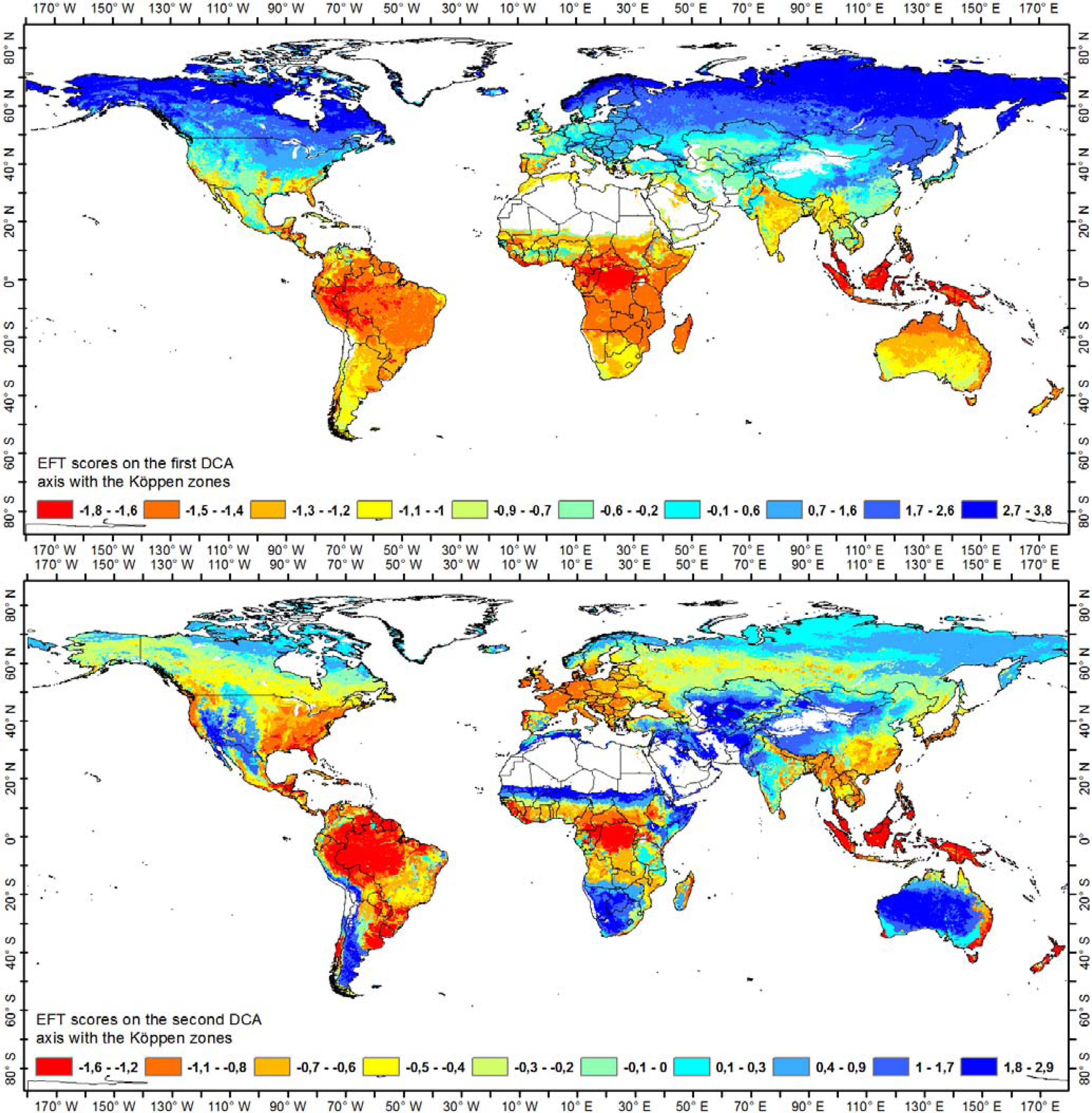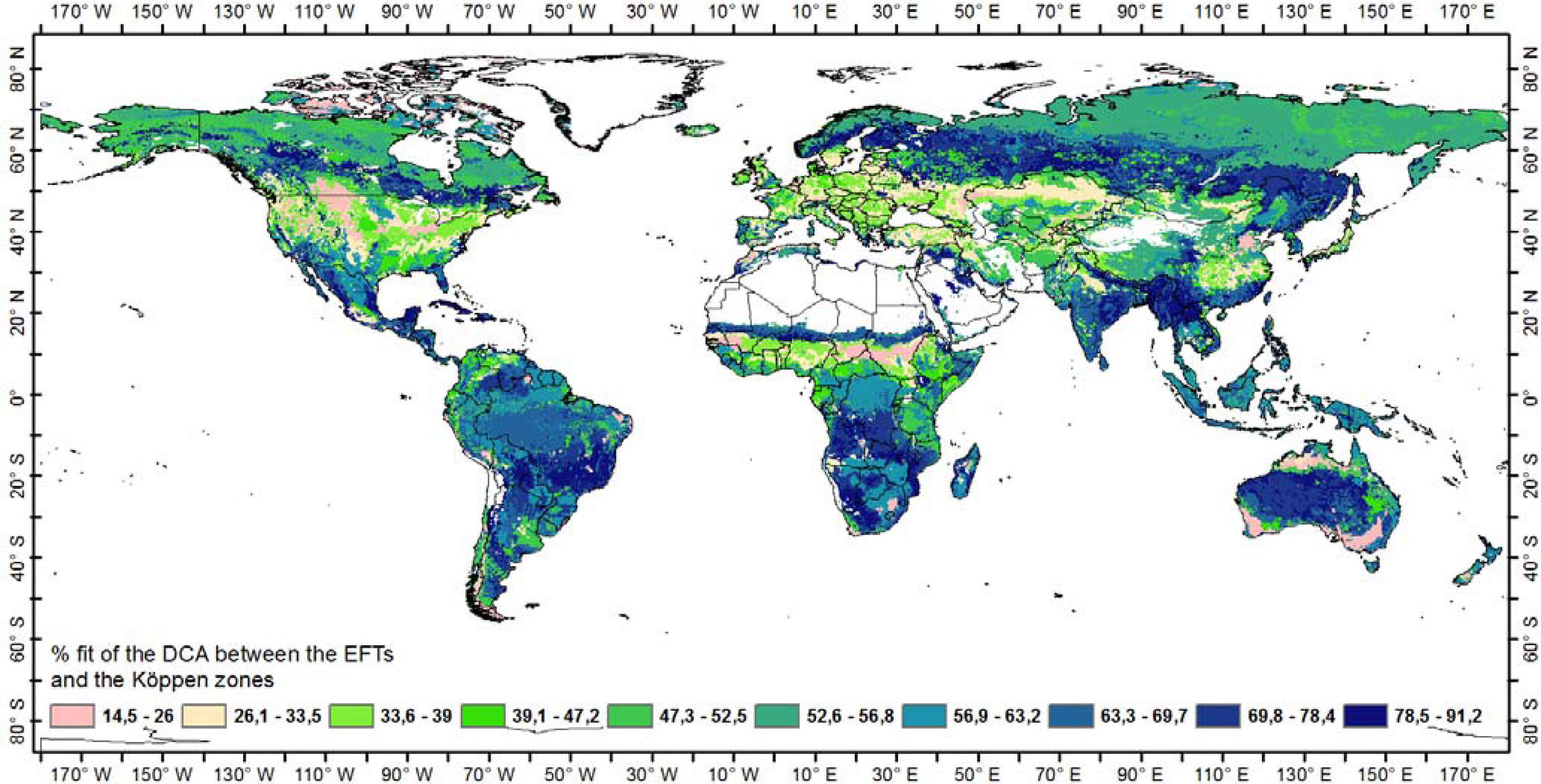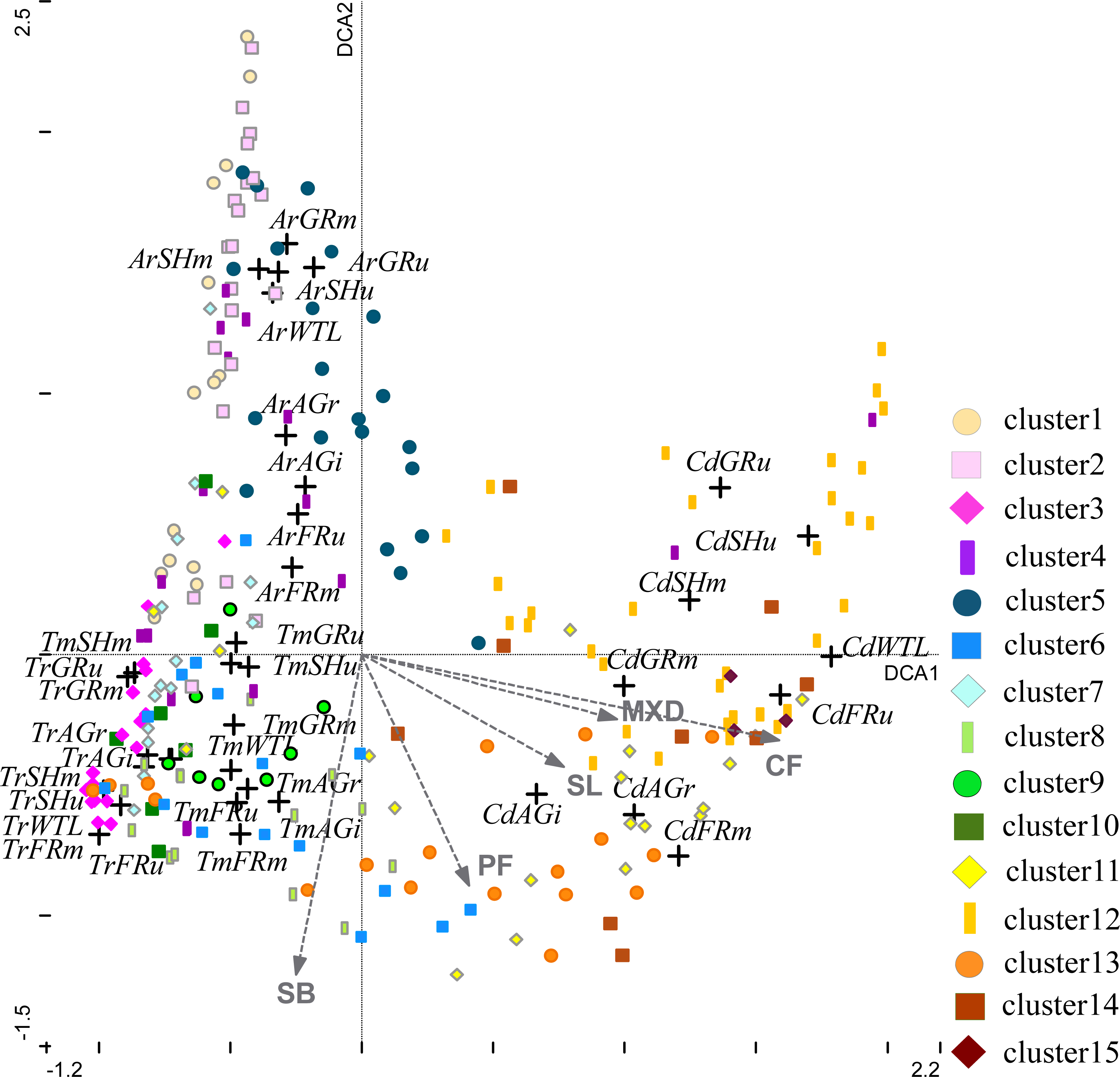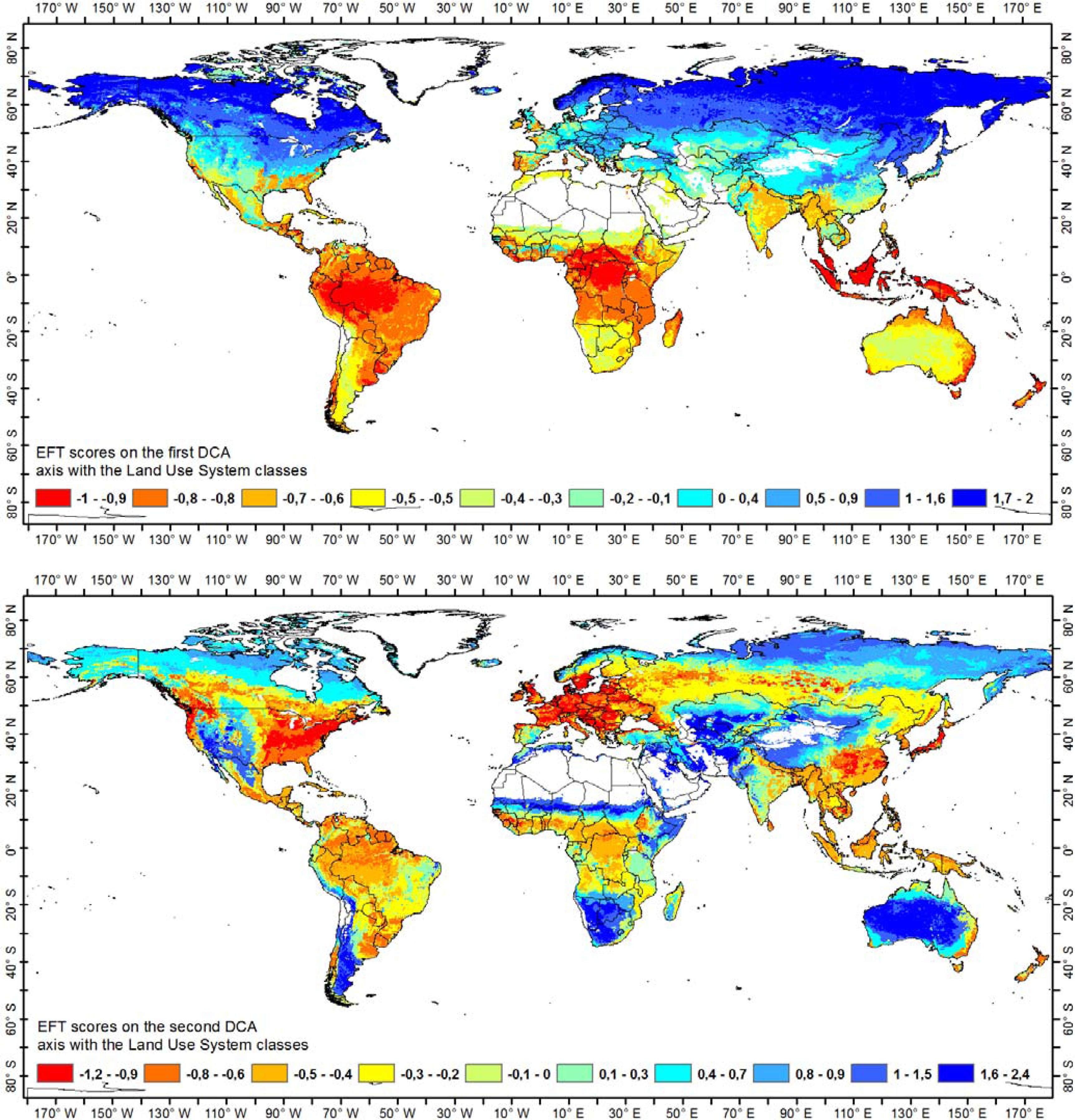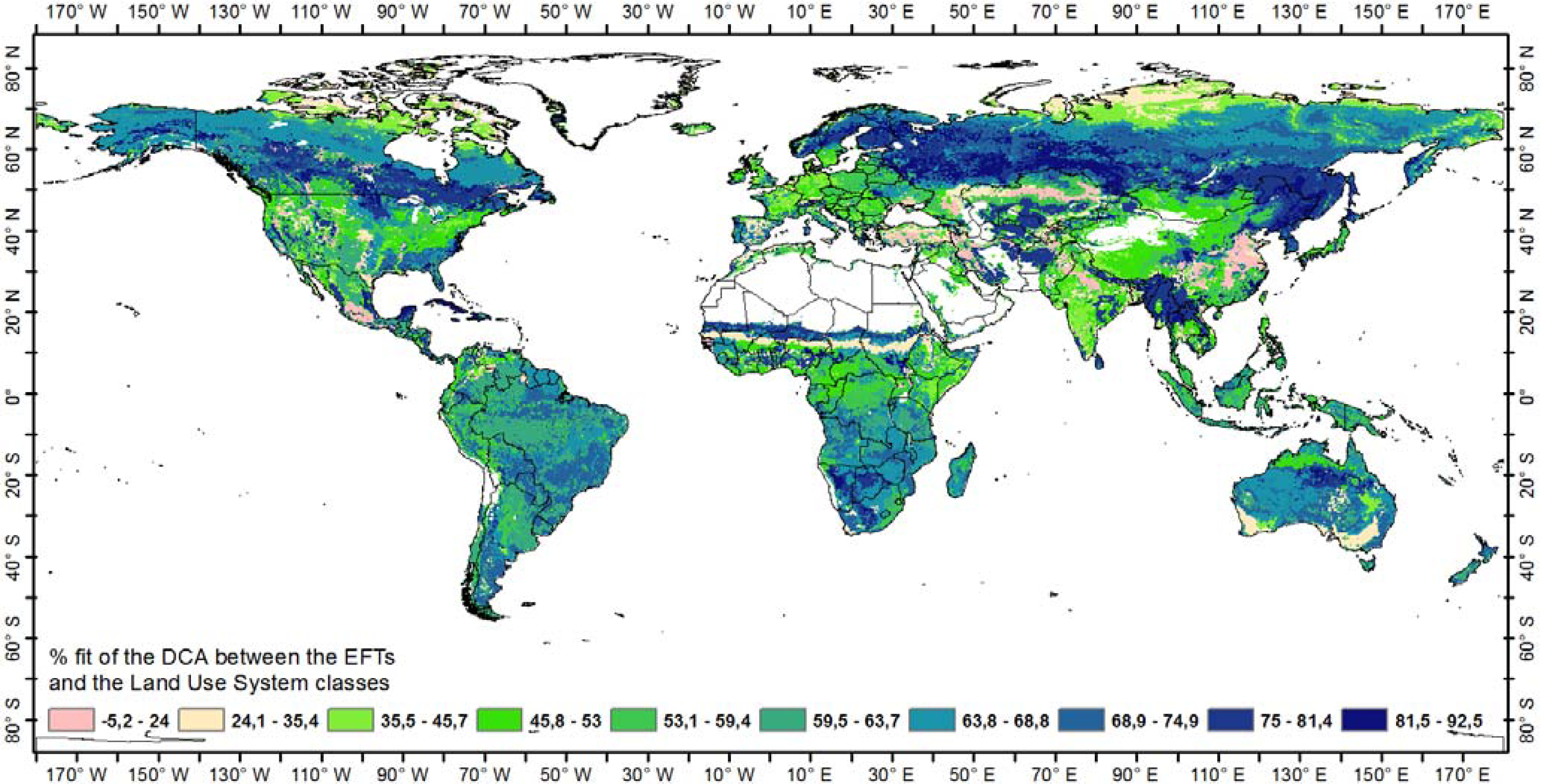1. Introduction
There is growing evidence that ecosystem degradation is largely due to intensive human resource use together with increasing awareness of the dependence of the global population on the globe’s ecosystem services [
1–
3]. Ecosystem degradation arises from long lasting loss of vegetation cover and biomass productivity over time and in space [
4], as result of a combination of natural/environmental and human/socio-economic drivers. The need for improved information on the status of lands and on degradation processes, along with standardized methodologies and understandable mapping, has to be addressed urgently. To tackle these complex global challenges, a monitoring and assessment system offering up-to-date information on the status and trends of ecosystem degradation and their causes and effects need to be developed. A useful monitoring and assessment system will supply indicators that account for the climate dependence of ecosystem functioning that is responsive to land cover and land use change while supplying knowledge of the temporal and spatial patterns of ecosystem dynamics at larger spatial scales. At global scales, such indicators are best derived from information on vegetation/land cover dynamics as core components to assess the state of ecosystem degradation [
5]. In particular, various aspects of vegetation productivity and phenology dynamics, reflecting land cover/use transitions that might lead to ecosystem degradation, need to be considered in a spatio-temporal context [
6].
The Local Net Primary Productivity Scaling (LNS) approach relates actual ecosystem degradation to the potential degradation of ecosystems [
7,
8] where remote sensing estimated productivity of each pixel is expressed relative to the 90 percentile observed in all pixels falling within the same homogeneous ecosystem unit. Thus the LNS method requires the characterization of ecosystem units with similar biomass production potential, which might be defined by biophysical information on vegetation, soils, terrain and climate [
7]. Besides this biophysical information ecosystems may be also characterized by the physiognomy and functional dynamics of the vegetation cover. Plant Functional Types (PFTs) are characterized by the physiognomy and functional dynamics of the vegetation and thus offer a possible framework for the identification of such homogenous ecosystem units providing a powerful tool in global change research [
9–
11]. This is because PFTs summarise the complexity of individual species and populations in recurrent patterns of plants that exhibit similar responses to biophysical environmental conditions. Hence, PFTs bridge the spatial and functional gap between plant physiology, land biophysical properties and ecosystem processes. Furthermore, identifying PFTs enables the assessment of ecosystem functions that might support predicting ecosystem response to human-induced changes [
12], because the functional composition of PFTs changes in response to human disturbances [
13,
14] as well as in response to global change of ecosystems [
15]. During the last decades the concept of Ecosystem Functional Types (EFTs) was developed for global scale assessment of ecosystems mostly based on the concept of PFTs, being defined as land surface areas with similar productivity (carbon gain/loss) dynamics.
Because of the large areal coverage and continuous temporal sampling, remotely sensed data provides a synoptic representation of vegetation dynamics in space and time and thus have a great potential for the assessment of ecosystems from regional to global scales [
16]. Satellite derived vegetation indices, such as the NDVI, have proven their value in the field of large scale monitoring of vegetation cover and dynamics for land degradation and desertification studies (for an overview see [
4,
7,
17]). Especially the de-convolution of the original time series into phenological and productivity metrics yield additional information on various aspects of vegetation dynamics and ecosystem functioning [
18] that can be related to land use [
19]. Monitoring vegetation phenology using satellite remote sensing [
20–
25] offers an optimal framework for ecosystem studies because
in situ phenological data are comparatively scarce in many parts of the world [
26] and because long time and large spatial scales can be addressed simultaneously. Monitoring vegetation phenology has also improved the understanding of the interactions between the biosphere, the climate and biogeochemical cycles [
16,
27–
29]. Lloyd [
30] has proposed the use of remote sensing derived phenology for the description of ecosystem functioning whereas Soriano and Paruelo [
31] proposed the classification of biozones for the assessment of EFTs based on the seasonal dynamics of vegetation indices derived from satellite observations. Using remote sensing for the evaluation of the functional components of the ecosystems and the characterisation of EFTs has been gaining importance in recent decades (see [
32] for a thorough review).
There is a need for quantitative methods to map the status and/or change of ecosystem services and thus supplying a standardized framework for ecosystem degradation studies. Therefore, in the present study we aim at identifying global EFTs [
12,
31–
34] in order to supply ecosystem degradation studies relating actual to potential degradation with homogenous biophysical units such as the LNS method [
8]. In our study, EFTs are defined as spatial units with similar patterns of seasonal phenology and productivity dynamics, also showing similar responses to changing natural and human induced environmental conditions following the ideas of Paruelo
et al. [
12] and Stow
et al. [
34]. Seasonal phenological and productivity dynamics are calculated from the GIMMS3g NDVI time-series (1982–2010) by decomposing the yearly NDVI signal into various metrics. Since we describe the functioning of global ecosystems within large climatic and biophysical gradients we derived a larger set of parameters indicating vegetation seasonal dynamics when compared to Paruelo
et al. [
12] and Alcaraz-Seguera
et al. [
35–
37]. As human activities such as abrupt land cover/land use change also play a significant role in land degradation processes [
7], EFTs should also relate to land use. Therefore, when characterising ecosystems, a compound set of functional attributes that describe vegetation dynamics should also be included. We illustrate that the global EFTs reflect climate and land use and therefore offer a meaningful, transparent and objective stratification for global ecosystem monitoring studies.
4. Discussion
Recent decades have seen an increasing need for information on ecosystem functioning to evaluate the human impact on the environment [
32]. A baseline characterization of ecosystem functioning is to be based on an up-to-date, effective and repeatable indicator system. Furthermore, regular updates are required as ecosystems rapidly change due to short time events such as droughts, floods, fires and human land use/intensification and longer term impacts due to climatic variability. Responsive and meaningful indicators are needed to assess the state and change of these ecosystems, including establishing causes and effects of degradation. With the aim to support monitoring of ecosystem functioning studies, we derived global EFTs from satellite measurements of seasonal vegetation dynamics. The EFTs showed a distinct spatial pattern in the PCA ordination but with overlap between the single categories conforming fuzzy boundaries of different ecosystems. Some overlap might also arise from the limits of remote sensing when observing seasonal vegetation dynamics over areas with low seasonality as e.g., over tropical areas or over areas with low vegetation cover. In fact, the tropical EFTs displayed strongly aggregated, thus less interpretable pattern when analyzing their correspondence with existing climate or with land use classifications. Nevertheless, the PCA ordination confirmed the potential of the EFTs in assessing the seasonal functioning of global ecosystems and the triplot enhanced the understanding of their phenological and productivity dynamics. Furthermore, it must be noted that droughts, floods, fires, land use intensification and longer term impacts due to climatic variability might change the functioning of the ecosystems. This is not reflected in the present study as we assessed EFTs based on the 30-year average functioning of the ecosystems. In order to assess changes in ecosystem dynamics, future studies should focus on yearly assessments and inter-annual variability of EFTs.
Climate is a main regional driver of ecosystem structure and functioning [
52]. Therefore, to be valuable indicators of ecosystem functioning, the EFTs need to agree with climate gradients. The RDA indicated that the gradient of the EFTs and the phenology and productivity parameters along this gradient follow the global pattern of climatic vegetation growth constraints. The high percentage of variation explained by the first two axes in the gradient analysis showed that the EFTs captured two strong global environmental gradients. The first and stronger gradient positively related to water constraints and negatively related to radiation. The second, weaker gradient of the EFTs showed strongest correlation with the temperature growth constraint and moderate correlation to radiation constraints. For example, EFTs in high latitudes were shown to be controlled by temperature whereas EFTs in the arid and semi-arid areas were associated with water constraints of vegetation growth. We found a good correspondence of the global spatial pattern of these constraints within the EFTs and results of other authors on patterns of ecosystem-climate relationships (e.g., [
29,
32,
44]). Nemani
et al. [
29] showed that water availability strongly limits vegetation growth over 40% of Earth’s vegetated surface, whereas temperature limits growth over 33% and radiation over 27%. Also Churkina and Running [
44] showed that especially water but also temperature controls global NPP accumulation whereas radiation has considerably lower importance. Although we used a different variable for productivity than Churkina and Running [
44], we obtained similar results showing that lowest productivity values were found in EFTs where water availability is the major climate constraint. We could further map a combined dependency of temperature and radiation using our extended set of variables. For instance, the yearly productivity expressed by the Cycling Fraction showed a strong association to temperature and radiation constraints for vegetation growth especially in the high latitudes. Furthermore, RDA suggested that the Maximum Day of the yearly vegetation signal is not related to water but rather to the constraining factor of temperature.
However, 50% of the variance in the global gradient of the EFTs could not be explained by the data indicating climatic constraints and variability and this should be attributed to other factors. On one hand, the climate and phenological data both have different time and spatial scales and associated noise/error that might play a role in the limited amount of explained variance. On the other hand, these results are consistent with Ivits
et al. [
19] showing a limited temperature and precipitation dependency of the remote sensing derived phenological and productivity parameters for Europe. That it is not only climate controlling the distribution of EFTs is further supported by the correspondence analysis between the Köppen climate zones and the EFTs, which was 47%. Especially the cold and arid zones scored high, showing that over these regions vegetation phenology and productivity agrees with bio-climatic classification systems, which are mostly dependent on climatic constraints [
19]. In other biomes, however, the correspondence was very low (low DCA fit) indicating that the Earth Observation derived variables comprise ecosystem functional information that is not inherent in bio-climatic classifications. Indeed, variations in vegetation signals are not only driven by climatic cycles but among others, by anthropogenic management practices [
7]. This suggests that the functional types of global ecosystems might be substantially influenced by anthropogenic activities as well and that the EFTs, to be valuable indicators of ecosystem functioning, should also reflect differences in land use.
Differences in land use vary locally depending on the nature of the human pressure [
32]. For example, harvest will characteristically cause earlier end of vegetation growing season and thus shorter season length as compared to natural areas. We therefore analyzed the relation between the EFTs and major global Land Use Systems testing how phenological and productivity parameters could enhance the understanding and characterization of these classifications. The influence of anthropogenic impacts on the EFTs was demonstrated by the 53.4% correspondence with the global Land Use Systems classes. Land use classes in the Cold and Arid zones were especially well discriminated by the EFTs whereas land use classes in the Tropical and Temperate zones, with more heterogeneous land use, were less interpretable. In a similar study, Ivits
et al. [
19] showed 85% correspondence of EFTs and European land covers using the 1km resolution SPOT VEGETATION data. In this global study based on the GIMMSs3g dataset, the results suggest that over more complex or intensively used areas the coarse spatial resolution of the remote sensing derived variables reach their limit in describing the spatial variability of vegetation cover. Hence, the response of EFTs to land use is dependent on the detail of spatial heterogeneity of the pixels potentially comprising all types of natural, semi-natural or intensively managed areas. Nevertheless, the present study demonstrated that EFTs do not only account for the climate dependence of ecosystem functioning but that they are also responsive to land use and thus supply indicators of the spatial patterns of ecosystem dynamics at larger spatial scales and offer an objective and repeatable method to characterise the functioning of ecosystems.
